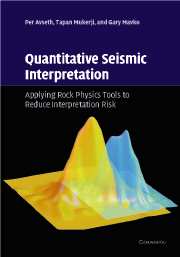Book contents
- Frontmatter
- Contents
- Preface
- 1 Introduction to rock physics
- 2 Rock physics interpretation of texture, lithology and compaction
- 3 Statistical rock physics: Combining rock physics, information theory, and statistics to reduce uncertainty
- 4 Common techniques for quantitative seismic interpretation
- 5 Case studies: Lithology and pore-fluid prediction from seismic data
- 6 Workflows and guidelines
- 7 Hands-on
- References
- Index
- Plate section
2 - Rock physics interpretation of texture, lithology and compaction
Published online by Cambridge University Press: 27 January 2010
- Frontmatter
- Contents
- Preface
- 1 Introduction to rock physics
- 2 Rock physics interpretation of texture, lithology and compaction
- 3 Statistical rock physics: Combining rock physics, information theory, and statistics to reduce uncertainty
- 4 Common techniques for quantitative seismic interpretation
- 5 Case studies: Lithology and pore-fluid prediction from seismic data
- 6 Workflows and guidelines
- 7 Hands-on
- References
- Index
- Plate section
Summary
How does it feel
To be without a home
Like a complete unknown
Like a rolling stone?
Bob DylanIntroduction
The main goal of conventional, qualitative seismic interpretation is to recognize and map geologic elements and/or stratigraphic patterns from seismic reflection data. Often hydrocarbon prospects are defined and drilled entirely on the basis of this qualitative information. Today, however, quantitative seismic interpretation techniques have become common tools for the oil industry in prospect evaluation and reservoir characterization. Most of these techniques, which are discussed in Chapter 4, seek to extract extra information about the subsurface rocks and their pore fluids from the reflection amplitudes. The seismic reflections are physically explained by contrasts in elastic properties, and rock physics models allow us to link seismic properties to geologic properties. Hence, the application of rock physics models can guide and improve on the qualitative interpretation. Figure 2.1 shows a schematic depiction of the relationship between geology, rock physics properties and seismic response.
In Chapter 1 we summarized how seismic properties are controlled by a wide range of different factors, including porosity, lithology, pore fluids and pressure. As of today, the application of rock physics in seismic interpretation has mainly been on prediction of porosity and discrimination of different fluid and pressure scenarios. Little work has been done on quantitative prediction of geologic parameters from seismic amplitudes, like sorting, cement volume, clay content, sand–shale ratio, and lithofacies.
Information
- Type
- Chapter
- Information
- Quantitative Seismic InterpretationApplying Rock Physics Tools to Reduce Interpretation Risk, pp. 48 - 110Publisher: Cambridge University PressPrint publication year: 2005
Accessibility standard: Unknown
Why this information is here
This section outlines the accessibility features of this content - including support for screen readers, full keyboard navigation and high-contrast display options. This may not be relevant for you.Accessibility Information
- 3
- Cited by
